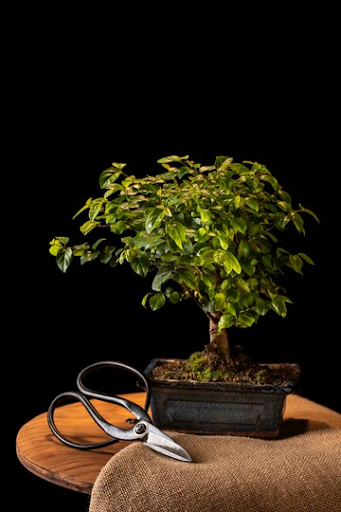Bonsai, the ancient art of growing miniature trees in containers, has fascinated gardeners and nature enthusiasts for centuries. Originating in China over a thousand years ago and later refined in Japan, bonsai is more than just a horticultural endeavor; it’s a practice that combines artistic expression, patience, and deep respect for nature. This comprehensive guide will walk you through what bonsai is, the principles behind it, and essential care tips to ensure your bonsai thrives.
What is Bonsai?
The term “bonsai” comes from the Japanese words “bon,” meaning tray or pot, and “sai,” meaning plant. Contrary to popular belief, bonsai is not a specific type of tree but rather a method of growing and training trees and shrubs to remain small while maintaining the natural shape and proportion of full-sized trees. Bonsai can be created from nearly any perennial woody-stemmed tree or shrub that produces true branches and can be cultivated to remain small through pot confinement and crown and root pruning. So, if you want to buy bonsai or you already have it, let’s read the care guide below and take care of your small friend
The Principles of Bonsai
Bonsai is rooted in several key principles, which guide the cultivation and aesthetic of the miniature trees:
- Miniaturization: The primary goal is to create a small, manageable tree that replicates the scale and proportion of a mature tree in nature.
- Proportion and Balance: A bonsai should have a balanced and harmonious appearance, with all parts of the tree proportionate to each other.
- Aesthetic Beauty: Bonsai artists aim to create visually appealing compositions that reflect the beauty and intricacy of nature.
- Naturalness: Bonsai should appear natural and unforced, mimicking the natural growth patterns and forms found in trees.
- Longevity: Bonsai are cultivated to live for many years, often passing down through generations.
Essential Bonsai Care Tips
Caring for a bonsai tree requires attention to detail and regular maintenance. Here are some essential tips to help you keep your bonsai healthy and beautiful:
1. Choosing the Right Tree
Selecting the right tree species is crucial for successful bonsai cultivation. Common species include Bonsai Juniper, Pine, Maple, and Ficus. Each species has its own specific care requirements, so it’s essential to choose one that matches your environment and experience level.
2. Proper Potting
The pot is an integral part of the bonsai’s aesthetic and health. It should complement the tree’s appearance and be shallow enough to restrict root growth, helping to maintain the tree’s small size. When potting, ensure that the soil mixture provides good drainage and aeration. A mix of akadama, pumice, and lava rock is commonly used.
3. Watering
Bonsai trees require careful watering to thrive. The frequency of watering depends on factors such as the tree species, pot size, soil mixture, and climate. Generally, bonsai should be watered when the topsoil feels slightly dry. Overwatering can lead to root rot, while underwatering can cause the tree to dry out and die. Using a watering can with a fine nozzle ensures even distribution without disturbing the soil.
4. Pruning and Shaping
Pruning is essential for maintaining the shape and size of your bonsai. Regular pruning helps promote dense foliage and a balanced structure. There are two types of pruning: maintenance pruning, which involves removing new shoots to maintain shape, and structural pruning, which involves removing branches to create the desired form. Wiring is another technique used to shape branches and trunks. Carefully wrapping wire around branches allows you to bend and position them as they grow.
5. Fertilizing
Bonsai trees need nutrients to grow and thrive, and because they are confined to small pots, they require regular fertilization. Use a balanced bonsai fertilizer with equal parts nitrogen, phosphorus, and potassium. Fertilize during the growing season, typically from early spring to late summer, and reduce feeding during the dormant winter months.
6. Repotting
Repotting is necessary to prevent the bonsai from becoming root-bound and to refresh the soil. Young trees should be repotted every 1-2 years, while older trees can be repotted every 3-5 years. The best time to repot is in early spring before new growth begins. When repotting, trim the roots carefully and replace the old soil with fresh, well-draining soil mixture.
7. Light and Temperature
Bonsai trees require adequate light to perform photosynthesis and maintain their health. Most species prefer bright, indirect sunlight. However, the light requirements can vary depending on the species. Ensure your bonsai receives the appropriate amount of light for its type. Additionally, bonsai trees are sensitive to temperature changes. Protect your bonsai from extreme temperatures, both hot and cold, and provide appropriate humidity levels, especially for indoor bonsai.
8. Pests and Diseases
Like any plant, bonsai trees are susceptible to pests and diseases. Common pests include aphids, spider mites, and scale insects. Regularly inspect your bonsai for signs of infestation and treat them promptly with appropriate insecticides or natural remedies. Good air circulation and proper watering practices can help prevent fungal infections and other diseases.
Conclusion
Growing a bonsai is a rewarding and meditative practice that connects you with nature and offers a unique form of artistic expression. By understanding the principles of bonsai and following essential care tips, you can nurture a beautiful and healthy miniature tree. Remember, patience and consistency are key in bonsai cultivation. Whether you’re a beginner or an experienced gardener, the journey of bonsai offers endless learning and satisfaction.
Embrace the art of bonsai, and let your miniature tree be a testament to nature’s beauty and your dedication to the ancient craft.











2 Comments